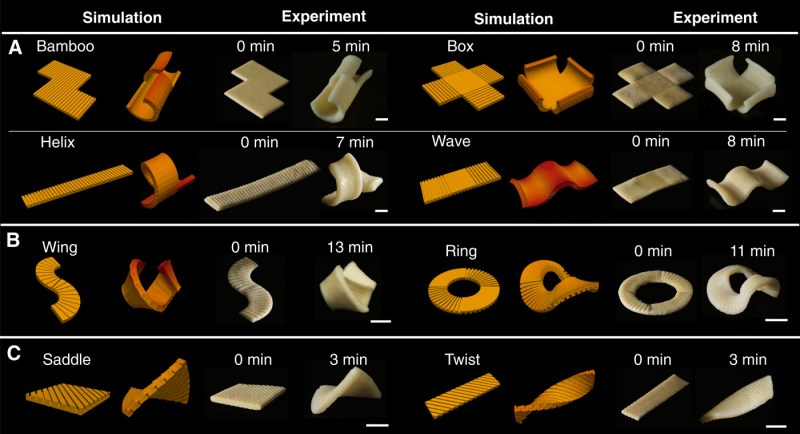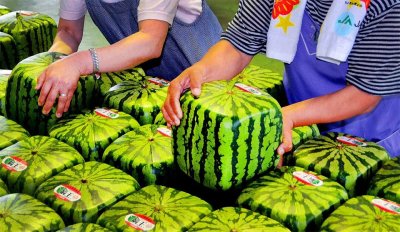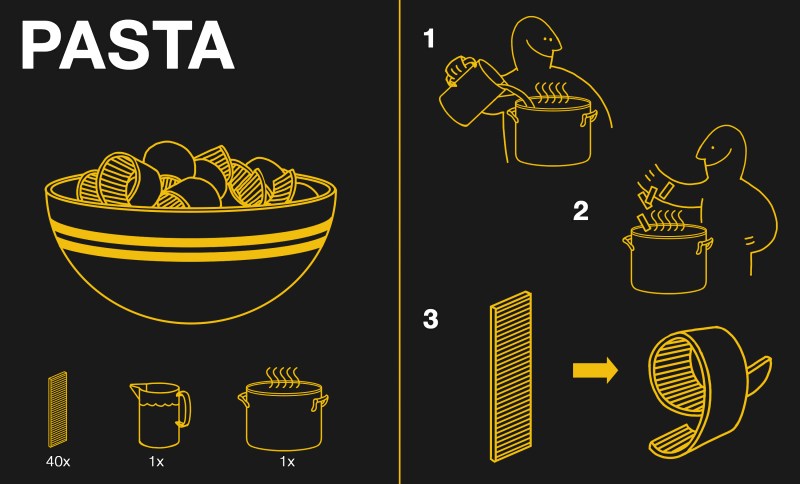When it comes to food packaging, there’s no bigger scam than potato chip bags, right? People complain about the air (nitrogen, actually) inside, but it’s there for a reason — nitrogen pushes out oxygen, so the chips live in a state of factory-fresh dormancy until you rip open the bag and release the gas. If you want flat-pack chips, there’s always those uniformly-shaped potato slurry wafers that come in a can. But even those usually manage to have a few broken ones.
On the other hand, no one complains about the extra space in their box of fusilli — that would be silly. But seriously, successfully shipping fragile foods requires either flat packing or a lot of extra space, especially if that food comes in a myriad of fun 3D shapes like pasta does. Everybody knows that 3D pasta is superior to flat pasta because it holds sauces so much better. The pasta must be kept intact!
The great thing about pasta as a food is that it’s simple to make, and it’s more nutritious than potato chips. Because of these factors, pasta is often served in extreme situations to large groups of people, like soldiers and the involuntarily displaced. But storing large quantities of shapely pasta takes up quite a bit of space. And because of all that necessary air, much of the packaging goes to waste.
So what if you could keep your plethora of pasta in, say, a filing cabinet? A research team led by the Morphing Matter Lab at Carnegie Mellon University have created a way to make flat-pack pasta that springs to life after a few minutes in boiling water.

This probably goes without saying, but they were inspired by IKEA’s packaging MO and sought to apply that flat-pack principle to food. The team has spent the last few years experimenting with 2D films of cellulose, protein, and starch to make them morph into 3D shapes as they absorb water. However, their method required additives, which likely wouldn’t fly with consumers or pasta manufacturers. So they came up with a way to do it by stamping the pasta, which they call “groove-based transient morphing“. Sounds to us like the one thing that can supplant lo-fi/hip-hop beats to study/relax to.
Why Didn’t We Think of This?
We love the simple utility of this so much. It’s like kerf-bending wood, or running a scissor blade along grosgrain ribbon in order to curl it. It would be dead simple to recreate this experiment at home with 3D-printed stamps, as long as you used food-safe mold release like the researchers did.
In order to find a suitable morphing mechanism for pasta, the team turned to PDMS, a silicone that is widely used to study kinetic behaviors. They experimented with groove types, weighing cuboid-shaped square wave grooves against frustrum-shaped Kit Kat side-view grooves, and found that the frustrum-shaped grooves maximized the curvature of the bent PDMS. With the morphing mechanism sorted, the researchers traded their lab coats for aprons and got to work applying it to dough.
The team starts with simple sheets of pasta made the traditional Italian way, with nothing but semolina flour and water. The dough is rolled out flat and cut down into shapes as normal, although most of them are new and exciting. Finally, they stamp the dough with pieces of plastic they designed and 3D printed, using a food-safe mold release in between. They started out with hand stamping, and as you can see in the video below, they ended up using a four-axis gantry for more precise impressions. Then it’s business as usual: boil the pasta for 7-12 minutes depending on shape and thickness, and watch the morphing take place. It takes longer to soften where the grooves are, and they don’t expand as much as the smooth parts. One team member took a matchbox of flat-pack pasta on a hike and cooked it over a fire to prove its utility.
Juicier Than Square Watermelons
A bit of quick research reveals that MIT had the same idea a few years ago. So why hasn’t the idea taken off? Obviously, someone needs to make a Kickstarter and stand up a flat-pack pasta company.

The question is, how much more would this pasta cost to consumers? It wouldn’t have to be much, right? We were neither business nor industrial design majors, but how much could the overhead be on a company like that? Surely flat-pack pasta is an idea that wouldn’t go limp, like square watermelons.
Growing watermelons inside of cube molds was supposed to be a refrigerator space-saving initiative that would make stacking a breeze. In reality, they cost $100-$200 each because they don’t all grow with perfectly vertical stripes or fill the mold. And because each must be picked before they’re ripe, they’re basically inedible and mostly used for decoration.
We imagine that if flat-pack pasta became a thing, it wouldn’t be perfect — there would probably still be a few broken ones just like those flat-pack potato wafers. But who cares? They’ll still hold sauce.















Instant noodles are pre-cooked and dried by deep frying. They can be cook in minutes or eaten as is. I have a few saved for blackouts with my penny stove. Nothing beats a hot meal when the heat and water are out. I actually tried cooking home made noodles one time, but it required more fuel and higher temperatures.
You really missed the point and didn’t bother to read or think.
It is a power blackout with no power, no water and cooking from a home made alcohol burner called a penny stove. Of course the amount of fuel and heat in the stove is very limited.
So hard times are a valid excuse for plastic pollution? Kiss the planet goodbye, cuz there are more bad times coming up.
Missed the point. TWICE!
I’ve seen enough similar comments from “X” to reckon they’re actively trolling.
You can re-hydrate instant noodles in cold water and then heat them up without water like fried noodles, so you save the fuel and time to boil water.
This may be a developing nation habit showing through, but If the the power goes out, all water I intend to consume gets sterilized, and boiling is an easy way to do this, especially since I’m already heating water for soup. Probably not necessary, but a little added precaution in case the water treatment plant isn’t working up to snuff with limited power.
Commenting from the developed world, it’s not unreasonable. Recent ice storm and resulting blackouts in TX caused my major city’s municipal water supply pumping stations to go offline. Loss of pressure triggered a city wide boil water notice for 3-4 days.
Home made noodles are more cost effective than instant noodles if you live off grid or rural. Firewood and fresh water are plentiful out in the mountains, but regular shipments of Maruchan are not.
Easier to deal with outages if you don’t depend on electricity for heat and water in the first place.
I can envision endless sheets being cut by a die-cutter on a rolling pin, just have to tesselate them correctly to cut with no waste. The ‘bamboo’ shape would likely be indistinguishable from bulk macaroni. If anything, it might be cheaper to manufacture.
I suppose you could also leave sprue between the ‘noodles’ and ‘shatter’ a sheet apart before cooking.
There should be no waste as any of the left over bits can be collected in the big ball of dough and rolled into sheets again. Optimizing the cuts reduce the extra steps.
I’m picturing something like this: https://youtu.be/w1W21ibTAMw?t=46
For people at home, I’d imagine someone 3d printing something like an embossed rolling pin.
I am absolutely charmed by the triumphant-unstoppable-march music that runs in the background as waves and waves of crackers inch ever forward. Their jaffa cake (what?) video is a cinematic masterpiece!
The reason why IKEA dramatically flatpacks is reducing transport (and storage) costs.
However, in supermarkets, “shelf space” is a dominant item – not the scarcity of it, but the presentation opportunity. That’s why a “teriyaki meal kit” contains a 250g bag of rice and two very flat bags of condiments (you have to add your own meat and vegetables) is over a litre in volume, to be able to stand up right and present something nice.
150g of pasta could be sold in a 150cm³ box, imagine 10*7.5*2 cm or basically the size of a pack of cigarettes. Marketeers think not many people will beleive this is a full meal base for two people.
While that’s true in brick and mortar retailers, this idea seems perfect for online delivery services like scamazon.
But going back to brick and mortar retail- it’s still advantageous to the company, as they can manufacture in whatever third-world cut-rate sweatshop has the cheapest indentured child laborers, flat pack it, then container ship it en masse to capitalist territory for repackaging in big ostentatious sprawlmart-shelf-worthy boxing. Cheap manufacturing, plus you can say it’s packaged in the USA*. (*Tiny print: made in poor-country-name-here)
I thought spaghetti was the solution for flat pasta? densly packed, cheap as heck and curls up when done ^_^
https://www.youtube.com/watch?v=WaQ_u2h8OOY
Lasagne is the solution for flat pasta. Lasagne were inventet by the Romans. And are a trucker’s favourite, actually.
The advantage of lasagne is that leftovers could be simply reheated without losing a lot of taste.
Pasta are not cheap here since the 2008 crash. Their price is about doubled here from before.
For the last couple of shopping trip I couldn’t find the bi-weekly deals any more.
I get pasta at the dollar store. You gotta check the expiration date but otherwise it’s as good as the stuff at the grocery store.
Xpiration date?
Yes, if it is more than 15 years past the expiration date, it might have an off-taste to it.
B^)
The artwork is great – is that one of Joe Kim’s?
I’m not sure who really runs into pasta storage volume issues, maybe backpackers or the military.
Those who regularly run into disaster, after disaster, after disaster.
It’s further up the supply chain: manufacturers, warehouses, distributors, shippers, and retailers. Space == money.
Space == money == more profit. Don’t expect people to solve problems when they profit from them. The trucking company makes more money shipping mostly empty boxes than it does shipping full boxes.
>>> The trucking company makes more money shipping mostly empty boxes than it does shipping full boxes.
Not really. When you think about it, the cost of shipping a load from point A to point B must always take into account the fact that that you are also shipping the truck and the driver(s). There’s a minimum cost for moving an empty multi-ton truck, and the driver costs n$/hour whether they’re hauling feather pillows or blocks of cement.
That’s why the cost/pound goes up as the density goes down. The cheapest per-pound rates are for NMFC class 50 loads (50 lbs./sq. ft. and up, e.g. flour) and the most expensive per pound rates are for NMFC class 500 loads (1 lb/sq. ft or less, e.g. ping pong balls).
Handling costs also play a factor. If all of those empty boxes are floor-loaded you’ll pay more than if they’re on pallets, even though the pallets add weight. That’s because it takes longer to load and unload the truck if the boxes are loose – those guys and gals on the dock cost the same per hour no matter what they’re unloading, and idle time for the driver also costs.
I wonder at what density “normal” shipping tips from being volume-intensive to weight-intensive.
Shipping SD cards in shoeboxes certainly is a volume-intensive way of shipping, which is why I find it strange that the post office prices based on weight, not volume.
Shippers including the USPS do have dimension limits for a particular rate class and charge more if you exceed them. I think the game is to pack as much as you can within the limits to avoid a higher rate and minimize the number of shipments.
All the big shippers charge you the larger of the “by weight” or “by volume” price, but, unless you’re shipping feather pillows, you tend to only see the by weight price.
Cous cous..
You’re welcome
Mic drop
“matchbox of flat-pack pasta on a hike and cooked it over a fire to prove its utility..” there is irony here..
I’m telling you, cous cous FTW!
Now use this new technique to make the newest pasta shape: cascatelli.
https://www.smithsonianmag.com/smart-news/get-lost-sauce-and-sink-your-teeth-new-pasta-shape-cascatelli-180977399/
.$18 per pound?
I’ll pass on that.
You don’t have to pass! We can make it cheaper, and flat! And it still holds a lot of sauce! Win win!
Now, make an extrusion plate that does the groovy thing with our KitchenAid pasta attachment.
YES! Take my money.
what if we shipped a bag of milled grain and the end-user can supply water and shape it on site? complete user configurability.
Yeah, but for the consumer time + effort == money, and remember “consumer” includes more than the home cook. I’ve made home-made pasta many times but I have the equipment, experience, and desire. Even then, most often my schedule and other needs call for premade.
I’ve also made pasta, though I didn’t have the equipment or experience, so I couldn’t roll it thin enough and it came out more like boiled bread sticks.
That sounds like you’re a bit of frying away from delicious.
When I was at University I met an Italian chick, and wanted to get to know her a bit better. During one of these conversations she opined that food in the UK wasn’t great, and I agreed. We then started talking about traditional Italian food. Apparently she and her whole family had strong opinions about pizza toppings – only the traditional ones would do – but she held the greatest contempt for pineapple. Apparently that was roughly equivalent to putting excrement on your pizza.
It was then that I knew that a pineapple-on-pizza-loving-degenerate like me didn’t have a chance with her. I can only imagine what food purists like her would think about these, even if they’re made with traditional ingredients.
I imagine that if these can be stacked properly in a container that they’ll break up a lot less as well. I wonder how easy it would be to stick a serving-sized block of them together in a way which would separate in the water and still cook easily?
If you want Italian girl to have passionate feelings for you you just calmly explain her that pizza if famous hawaian dish that was brought to italy but because they could not afford pineapple they just didn’t add it. Margarita is nothing but hawaian with no ham and pineapple. Now keep that level of emotional involvement and just change it’s polarity.
You welcome.
I don’t think so.
Italian purist here. Usually we don’t complain about other type of pasta but how that is made, cocked and seasoned.
If you follow the basic rules to cook the pasta, use Mediterranean ingredients we don’t complain about new type of food.
Put your water pot on the heater and reach the boiling point. Put the salt (you can add the salt before the boiling point, but the water need more time to boiling) and your durum wheat pasta, and follow the packaging time of cocking (8-11 minutes usually, but can change between types). Stir the pasta time to time until you rich the final time, and then drain the pasta. Keep some cooking water (150-200 ml in container) and you can use it during the mantecatura/creaming; that water is rich of starch and help to create a beautiful cream in the sauce.
And yes, pineapple on pizza is a crime against humanity.
I hate it when people put change the dish drastically, but get to keep calling it a pizza.
It is the same as people here sometimes fry slices of meat and call it kebab. It is not a kebab.
The same thing happens with chevapi in somun. They dont even understand what a somun is and they serve standard bread. I have to research every restaurant before I go to eat there. Most of the time I eat at home what i make myself.
It is one thing to destroy a meal by ingredients that just don’t go there, but it is a problem when the same people try to convince others that it is still the same dish.
Eat what you want, just don’t try to make me eat it.
Once a friend of mine asked for ketchup in Sarajevo. They almost threw him out of the restaurant. :D
Good thing he asked after we all got our portions so no one could spit in our meal. :D :D
Bah. My cascatelli comment was supposed to go here.
Stupid comment system.
Italian here. Leave my pasta alone.